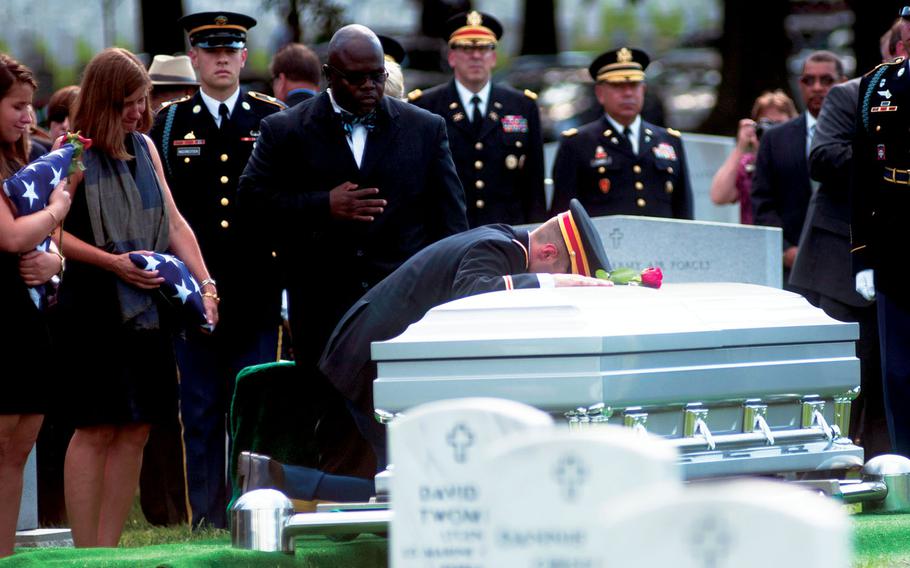
Army 1st. Lt. Matthew Greene, the son of slain Maj. Gen. Harold J. Greene, mourns at his father's casket after laying a rose at Arlington National Cemetery on Aug. 14, 2014. The two-star general was killed in an insider attack in Afghanistan on Aug. 5. (C.J. Lin/Stars and Stripes)
U.S. Army Maj. Gen. Harold Greene was shot and killed by an Afghan soldier at a Kabul training center, making him the highest-ranking U.S. officer to die in an attack since 9/11, and the first general officer killed overseas since the Vietnam War.
The shooting occurred Aug. 5 at Marshal Fahim National Defense University. Greene and other coalition leaders went there for a series of briefings on ongoing construction projects designed to help the Afghan National Security Forces churn out high-quality officers. The facility was viewed as a critical component of the U.S. and NATO strategy to prepare the ANSF to fend off the Taliban after international forces withdraw.
The final briefing — an impromptu event — took place in a confined area outside a troop barracks.
As the briefing ended, an Afghan soldier named Rafiqullah opened fire on the group with his M-16 rifle from the bathroom window of the nearby barracks.
Greene, the deputy commander of Combined Security Transition Command-Afghanistan, was shot multiple times in the head, neck and pelvis, and died instantly. Eighteen others were wounded, including German and Afghan general officers. The shooter was killed during a gun battle after coalition forces returned fire.
Despite his high rank, officials believe that Greene wasn’t specifically targeted.
Based on information gleaned from interviews, “it appears the shooting was not premeditated and the shooter simply took advantage of a target of opportunity provided by the close gathering,” U.S. Central Command stated in a report after investigating the incident.
The Taliban have taken credit for many insider attacks, but in this case investigators did not find any clear links between Rafiqullah and the Taliban or other extremist groups.
Coalition leaders have said that the vast majority of insider attacks are due to cultural differences and personal hatred, rather than infiltration of the ANSF by insurgents.
Rafiqullah’s motive is still not entirely clear, but an Afghan translator told investigators that there were several instances in which Raifqhllah demonstrated disdain for Americans.
The Greene killing was the most high profile of all the insider attacks in Afghanistan. Since 2008, there have been 89 so-called “green on blue” incidents, according to the Long War Journal, which tracks these events.
The spike in the number of insider attacks in 2012 compelled the coalition to put in place new security measures, including improved vetting of ANSF recruits and additional force protection.
Still, the Greene killing shows that the risk remains.
“The outcome of this case shows what can happen when we combine a determined shooter with a target of opportunity,” Army Brig. Gen. Donald Jackson, Jr. the investigating officer, wrote in the report. “This incident does … bring into question a fundamental problem set in how we must balance the need for maintaining an environment of trust and confidence with our Afghan partners, while providing adequate force protection for our advisory team members and leaders” as the training mission continues.
harper.jon@stripes.com Twitter: @JHarperStripes